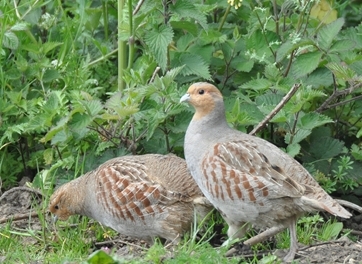As the Game & Wildlife Conservation Trust (GWCT) prepares to start the autumn brood count for its Partridge Count Scheme (PCS), it is an anxious wait to see how the changeable weather conditions this summer will have affected the breeding success of grey partridges across the country.
 “We are preparing ourselves for the fact that this may not be a good year for grey partridge broods;” comments Neville Kingdon, PCS Co-ordinator at GWCT.
“We are preparing ourselves for the fact that this may not be a good year for grey partridge broods;” comments Neville Kingdon, PCS Co-ordinator at GWCT.
“In general terms, the summer’s insect numbers in crops are determined by the weather in April and May. A cold, wet spring leads to fewer insects such as caterpillars, beetles and bugs. These fat, juicy, protein-rich insects are the staple food of grey partridge chicks and in the fortnight after hatching, their survival depends on insect availability around ground level. In addition, prolonged wet weather in late June, which is the time of ‘peak hatching’, brings concerns that if newly hatched chicks get cold and damp they can quickly perish.”
With changeable weather, the importance of good brood-rearing cover cannot be overstated. It must be insect-rich because chicks need to feed on up to 2,000 insects each per day to grow. Good brood covers mean a plentiful supply of chick-food being readily available and ensure the effects of bad weather on chick survival is minimised.
Neville continues; “It’s not all bad news. While not a great year, it may not as bad as we fear. Despite the unhelpful weather for insects generally, a preliminary look at our chick-food insect samples would point to it being better that 2012, which was a really bad year. So there is a chance that insects may have been sufficient or late broods might have fared better than expected.
“However, the uncertainty just confirms the fact that we need to find out what has actually happened. The PCS will provide site-specific feedback to help land managers make targeted improvements to how they manage their land. We know farmers and gamekeepers take pride in having wild grey partridges around and it’s an easy bird for them to see and record. Now we need as many farmers and gamekeepers as possible to find out how wild greys have fared on their ground.”
The PCS is a free and voluntary scheme that is open to any farmers, landowners and gamekeepers. They are invited to take part by counting their partridges and submitting the counts to our national database. There are no restrictions on how many birds are needed to qualify. For more information on how to join the scheme please click here.
Wild grey partridges, as a flagship indicator species, are a great barometer of wider farmland biodiversity. What’s good for wild greys is also good for much more in our countryside, especially other struggling farmland birds.
Notes to editors
The Game & Wildlife Conservation Trust – providing research-led conservation for a thriving countryside. The GWCT is an independent wildlife conservation charity which has carried out scientific research into Britain’s game and wildlife since the 1930s. We advise farmers and landowners on improving wildlife habitats. We employ more than 60 post-doctoral scientists and other research staff with expertise in areas such as birds, insects, mammals, farming, fish and statistics. We undertake our own research as well as projects funded by contract and grant-aid from government and private bodies.
For information, contact:
Eleanor Williams
Telephone: 07592 025476
Email: press@gwct.org.uk